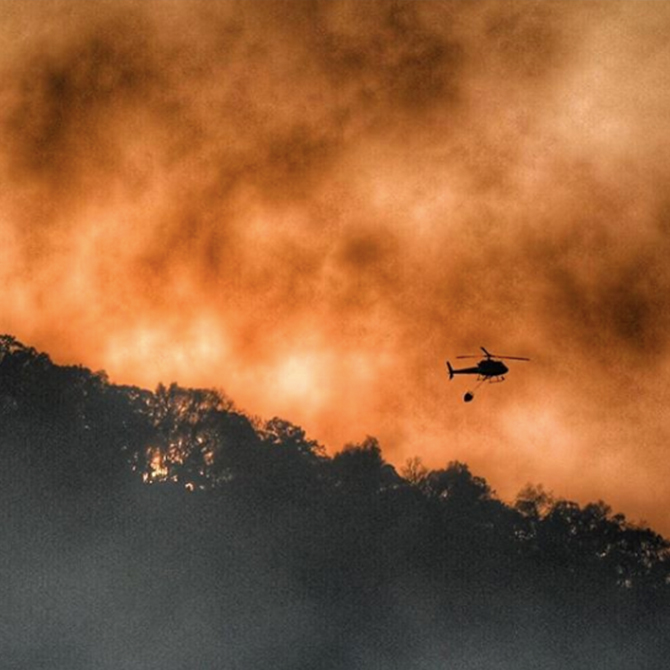Northern Thailand’s forests are burning once again, putting entire villages at risk, leaving dozens of local officers dead and depleting the forest’s ecosystem. Forest fires are a seasonal problem for the locals, with deforestation for agriculture being cited as the main cause. This year poses one of the worst wildfires in decades, yet there have hardly been any reports about the crisis from local media, with most available information detailing the (inconclusive) extent of damage done being shared through social media.
T/W: The images below may be disturbing or distressing to some.
How did it start?
Although the actual cause is still unclear, Narumon Pinyosinwat, a Thai government spokeswoman alleges the recent drought, slash-and-burn agribusiness practises, strong winds trapping polluted air in the northern region as well as arson as possible causes for the devastation.
These are all plausible and likely. However—whatever the root cause is—drought and strong, polluted winds as a result of climate change have left the hotspots of the region vulnerable to the rapid spread of wildfires, especially in Chiang Mai, which has once again been declared the world’s most polluted city. However, the alienation and demonisation of the local communities of “forest dwellers” by the authorities have also been a great setback in the management of the fires.
The reality is that local villages and communities within the forests and mountains of Northern Thailand have been on the forest fire frontlines every year, possessing the most innate understanding of fire control methods. After all, the forests and mountains are their home and sole source of food–why wouldn’t they try to protect it? These small communities of people are the ones who create fire buffer zones by burning fuel loads (flammable foliage), desperately trying to prevent and manage the crisis. However, the government has now declared a zero-burn policy in the forests, preventing locals from upholding these practises, thus overloading the forest with fuel loads and leading to the quick spread of the flames.
In addition, the fires have become so devastating because the locals have been deprived of the means to adequately deal with it. As a result of global warming, the rivers at the top of the mountains that used to provide water to douse any flames while acting as fire barriers have all but dried up–months before the official ‘hot season’ had even begun. Local villagers are thus struggling to save themselves and their homes after being left defenceless; forced to resort to primitive methods of fire extinguishing such as using leaf blowers, axes and knives. It’s an incredibly dangerous task, having already left several villagers to perish at the hands of a sudden change of wind.
In addition to their efforts, helicopters, drones and paragliders have been deployed by authorities to manage affected areas; as well as soldiers who have been tasked with detecting the fires. The issue is that government manpower and resources have been stretched thin between the fires and the COVID-19 pandemic, and they are ill-equipped to deal with the situation.
Okay, so it’s bad. Why haven’t we heard about it?
It’s no secret that COVID-19 is at the forefront of everybody’s minds at the moment, with the pandemic predicted to last until this time next year—yes, 2021. However, although it is definitely a big contributor to the media’s silence, others suggest that there are more sinister reasons behind the underreporting of the forest fires.

Specifically, users on social media have blamed corruption within the government–Instagram user Junny stated that “wildlife animals are dying… and no one helps us, (not) even our government”, adding that “the government and Thai mass media are still ignoring it because of powerful people who don’t want international people to know the news and I don’t know why”. Others suggested that the alleged cover-up was an attempt to uphold a facade and save face amid the disaster.
Regardless, the forests have been blazing away from at least the night of the 25th of March, with both city and forest residents being subjected to record high levels of pollution as a result. The main question is–how can we help?
Unfortunately, the answer to that at the moment is… not much. However, we can keep spreading the word about it to raise awareness about the critical situation, just like we did for the Australian bushfires and 2019 Amazon rainforest wildfires. Hopefully from there, we’ll start seeing some relief funds being set up. In addition, climate change has been a big catalyst in the rise of forest fires that we’ve seen in this year alone (and we’re only in April). So, on a more long-term scale, we should be looking for solutions to reduce our global carbon footprint–it’s clear that we’re not doing nearly enough as it is and that needs to change.
| SHARE THE STORY | |
| Explore More |




